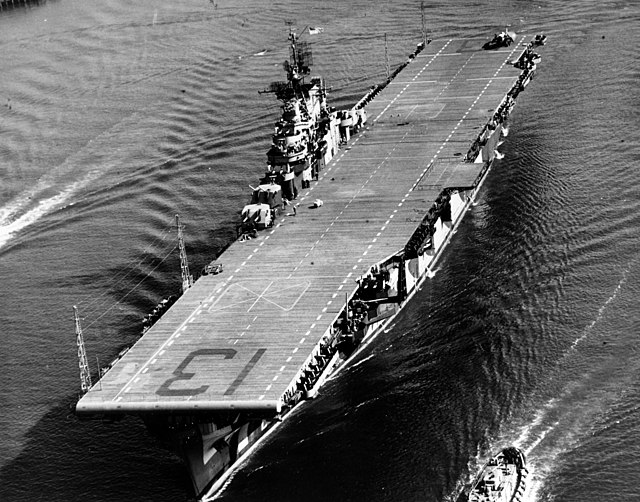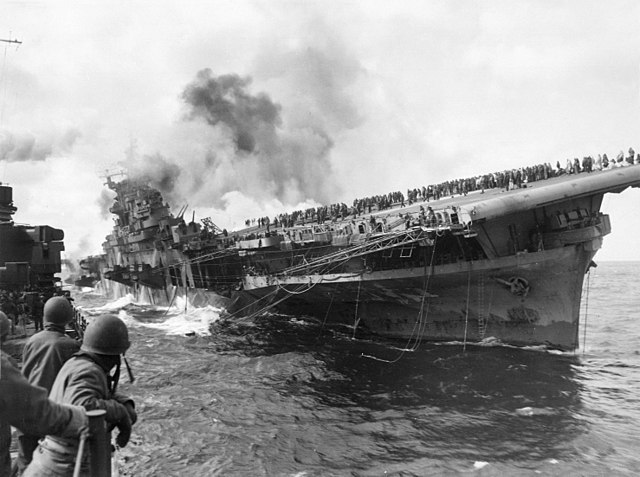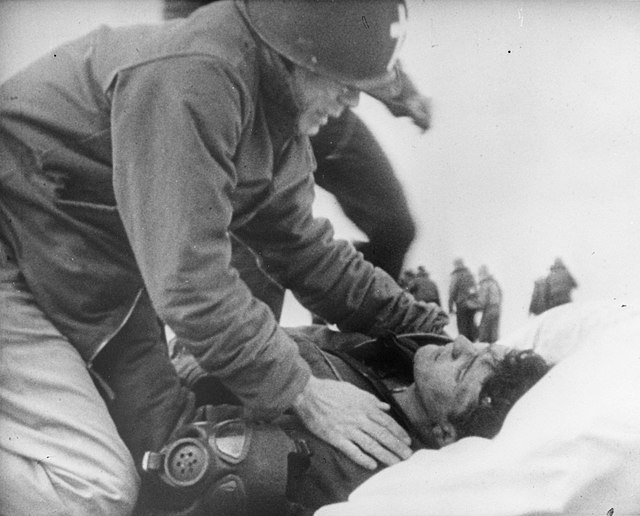The USS Franklin (CV-13) was a member of the Essex-class of aircraft carriers, which had a successful design that served well during World War II and into the post-war years. The fifth Essex-class carrier to be launched, Franklin was present in the Pacific Theater and saw plenty of action. While she earned four battle stars over her career, over 700 of her crew were killed in a vicious Japanese air attack toward the end of the war, making her the most heavily damaged carrier to survive the conflict.
The USS Franklin‘s early service
The USS Franklin was laid down on December 7, 1942, the first anniversary of the attack on Pearl Harbor. Named in honor of American Founding Father, Benjamin Franklin, the carrier was launched on October 14, 1943 and commissioned a few months later, on January 31, 1944. Following a shakedown cruise in the Caribbean, she headed for San Diego to begin combat training.

By June 1944, Franklin was on her way to Enewetak Atoll, which today is home to the highly-radioactive and controversial Runit Dome. The carrier was thrust straight into action, with her aircraft performing sorties on the Bonin Islands and supporting the assault on the Mariana Islands. Following these successful attacks, Franklin‘s aircraft operated over Iwo Jima, Chichi Jima and Haha Jima, working to neutralize the islands’ military infrastructure.
Throughout July, Franklin staged air strikes against the defenses on Guam, in preparation for a US assault. Her aircraft then provided fire support to the troops on the ground and assisted them to get a foothold, after which she and her aircraft performed air strikes on and photo reconnaissance of the Palau Islands.
All this was done in the carrier’s first month of combat.

Franklin resumed operations around the Bonin Islands at the beginning of August 1944, engaging airfields, vessels and aircraft while completing additional aerial reconnaissance. The following month, she resupplied in Saipan, after which she supported the invasion of Peleliu.
Action in the Philippines
Following Peleliu, the USS Franklin made her way to the Philippines, where she helped soften enemy positions and defense on Leyte. During this, her deck edge elevator was hit by a bomb, injuring 22 crew members and killing three more. Much of the Philippines was covered with Japanese airbases, which were a serious threat to any land invasion. While combating this threat, Franklin and the other vessels in her task force came under heavy attack from kamikaze aircraft.

In mid-October 1944, a wounded Japanese Betty (Mitsubishi G4M) bomber went down fighting when it turned toward Franklin in a kamikaze attempt. Thankfully, it skimmed her flight deck and caused only minimal damage.
During the actual invasion of the Philippines, Franklin downed 11 Japanese planes. On October 24, her aircraft attacked the Japanese First Raiding Force, sinking the destroyer Wakaba and helping to bring down the Yamato-class Musashi, the heaviest and most powerful class of battleship ever built.

A few days later, Franklin and three other carriers became the focus of a Japanese kamikaze attack. While most of the aircraft were shot down, a kamikaze slammed through Franklin‘s flight deck, killing 56. Immediately after, another kamikaze bomb just missed the carrier, before crashing into the USS Belleau Wood (CVL-24).
Both Franklin and Belleau Wood were able to travel to Ulithi Atoll for some light repairs, after which Franklin was temporarily retired to the Puget Sound Navy Yard.
Massive loss of life
After repairs were completed, the USS Franklin returned to combat in March 1945, just in time to support American movements on Okinawa. She was close enough to Japan to launch strikes against the mainland, coming within 50 miles of shore – closer than any other carrier. As such, this left her in a precarious situation.

On the night of March 19, Franklin‘s crew was called to its battle stations 12 times. During a temporary downgrade in the severity of the situation, the crew retired. However, what they didn’t know was that a lone Japanese bomber had made its way to the carrier.
The bomber dropped two bombs, both of which tore through Franklin‘s desk, causing devastation above and below her decks. When the bombs hit, there were 31 fully-loaded aircraft on the carrier’s flight deck, as she was about to launch another wave of attacks. These planes were immediately engulfed in flames, setting off their ordnance. The rockets aboard the aircraft ignited, setting off their motors and sending them flying around the hangars below deck, while fuel exploded in an immense fireball.
Nearby ships rushed to the burning carrier’s aid, even placing their own hulls against her to allow her crew to escape. Hundreds remained on board, working to save the otherwise doomed vessel. According to the Navy, 724 men died in the incident, while another 265 were wounded. However, those totals are believed to be higher, given the recent discovery of additional documents.

Franklin managed to make it to Ulithi Atoll, then Pearl Harbor, before finally arriving at the Brooklyn Navy Yard on April 28, 1945. She was repaired and returned to serviceable condition, but was decommissioned just two years later. In 1966, the carrier was scrapped.
Over the course of WWII, the USS Franklin lost over 900 men and suffered severe damage, giving her the distinction of being the vessel that sustained the heaviest damage while simultaneously surviving the conflict
